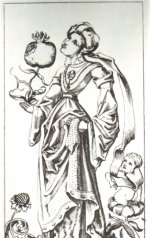Fulgour
Tuu-Bad
I wonder if THOTH devotees cringe at the mention
of "Gypsies" because the Thoth was originally titled:
The Tarot of the EGYPTIANS (Thanks, Lady Harris!)
Here's a blurb for Le Tarot des Gitans
This is a set of French tarot cards In excellent condition. There are 78 cards in the game. The French name is "Les Tarots des Gitans" which means the Gipsies tarot.
Historians associates gipsies to Egypt and Greece. Voltaire himself in the XVIII th century presents Gipsies as the descendants of ancient priestesses of ISIS the black goddess that we find in the gipsy cult under the name of Sarah the Egyptian. Gipsies are also called ROM (Sanskrit word meaning "Free man").
About 1000 years ago they travelled to India and through Asia to Europe stopping in Syria, Egypt, and Persia.
In 1417 a group of nomads with dark features, came to Germany, and Holland, this is where the word "Flamenco" came from as the Deutsch speak Flemish. They came to Paris in 1427.
Today, still, even though they adopted the religion of the places they have been, gipsies stay true to the universe of the elements to which they belong and face day after day : water, fire, earth, air, the sun, the moon and the stars.
Published in 2000, by De Vecchi in Paris. Beautiful graphics by M. Ameli.
Sorry, Crowley (oompa-oompa)...
there's no Kabbalah either.
I wonder if THOTH devotees cringe at the mention
of "Gypsies" because the Thoth was originally titled:
The Tarot of the EGYPTIANS (Thanks, Lady Harris!)
Here's a blurb for Le Tarot des Gitans
This is a set of French tarot cards In excellent condition. There are 78 cards in the game. The French name is "Les Tarots des Gitans" which means the Gipsies tarot.
Historians associates gipsies to Egypt and Greece. Voltaire himself in the XVIII th century presents Gipsies as the descendants of ancient priestesses of ISIS the black goddess that we find in the gipsy cult under the name of Sarah the Egyptian. Gipsies are also called ROM (Sanskrit word meaning "Free man").
About 1000 years ago they travelled to India and through Asia to Europe stopping in Syria, Egypt, and Persia.
In 1417 a group of nomads with dark features, came to Germany, and Holland, this is where the word "Flamenco" came from as the Deutsch speak Flemish. They came to Paris in 1427.
Today, still, even though they adopted the religion of the places they have been, gipsies stay true to the universe of the elements to which they belong and face day after day : water, fire, earth, air, the sun, the moon and the stars.
Published in 2000, by De Vecchi in Paris. Beautiful graphics by M. Ameli.
Sorry, Crowley (oompa-oompa)...
there's no Kabbalah either.



